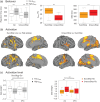Dissociable Fronto-Operculum-Insula Control Signals for Anticipation and Detection of Inhibitory Sensory Cue
- PMID: 27473319
- PMCID: PMC6059112
- DOI: 10.1093/cercor/bhw219
Dissociable Fronto-Operculum-Insula Control Signals for Anticipation and Detection of Inhibitory Sensory Cue
Abstract
The ability to anticipate and detect behaviorally salient stimuli is important for virtually all adaptive behaviors, including inhibitory control that requires the withholding of prepotent responses when instructed by external cues. Although right fronto-operculum-insula (FOI), encompassing the anterior insular cortex (rAI) and inferior frontal cortex (rIFC), involvement in inhibitory control is well established, little is known about signaling mechanisms underlying their differential roles in detection and anticipation of salient inhibitory cues. Here we use 2 independent functional magnetic resonance imaging data sets to investigate dynamic causal interactions of the rAI and rIFC, with sensory cortex during detection and anticipation of inhibitory cues. Across 2 different experiments involving auditory and visual inhibitory cues, we demonstrate that primary sensory cortex has a stronger causal influence on rAI than on rIFC, suggesting a greater role for the rAI in detection of salient inhibitory cues. Crucially, a Bayesian prediction model of subjective trial-by-trial changes in inhibitory cue anticipation revealed that the strength of causal influences from rIFC to rAI increased significantly on trials in which participants had higher anticipation of inhibitory cues. Together, these results demonstrate the dissociable bottom-up and top-down roles of distinct FOI regions in detection and anticipation of behaviorally salient cues across multiple sensory modalities.
Keywords: dynamic causal modeling; fMRI; human; prefrontal cortex; response inhibition.
© The Author 2016. Published by Oxford University Press. All rights reserved. For Permissions, please e-mail: journals.permissions@oup.com.
Figures




References
-
- Aron AR, Fletcher PC, Bullmore ET, Sahakian BJ, Robbins TW. 2003. Stop-signal inhibition disrupted by damage to right inferior frontal gyrus in humans. Nature Neuroscience. 6:115–116. - PubMed
-
- Button KS, Ioannidis JP, Mokrysz C, Nosek BA, Flint J, Robinson ES, Munafo MR. 2013. Power failure: why small sample size undermines the reliability of neuroscience. Nat Rev Neurosci. 14:365–376. - PubMed
MeSH terms
Grants and funding
LinkOut - more resources
Full Text Sources
Other Literature Sources

